let me cover some of the basics of what goes into a bait tank.
Filtration and Aeration!!! A cheap way to do that is with a Corner filter especially if you only intend to keep a small amount of bait say in a bucket or small storage tote.
Corner Filter
If you put a box filter in the corner where its most convenient, it becomes a corner filter. Somehow, more people refer to this kind of filters as corner filters than box filters so we'll use the term corner filter here. Corner filters come in different shapes and sizes, but the concept is the same.
1. Air is pumped using an airpump into the corner filter
2. air bubbles rise along a passageway
3. rising air bubbles pushes water out of the passageway
4. water is drawn in to past the filter media contained in the box to replace the displaced water
Corner filters are actually for biological filteration. The wool at the water intake is used only to prevent premature clogging up of the micropores of the corner filter. In deployments where only wool/sponge is used and no porus bio media is used, the wool/sponge serves as the media for beneficial bacteria to grow on. Corner filters are not effective for mechanical filteration as the suction force is not strong enough to move solid wastes.
Corner filters are actually effective filteration provided the bioload it is supporting is small. Due to the limited amount of bio media a box filter can hold, it cannot provide enough surfaces to support a large bioload tank.
The advantage of using box filter is that it provides aeration and filteration at the same time. It is an effective way to provide filteration for a number of small tanks, you only need a strong air pump with air tubes going to all the tanks with corner filters.
Another advantage of corner filters is that they do not have a powerheads. Due to this, corner filters are very useful for tanks that need to keep the temperature cool. Different powerheads heat up the water to different extents, but without powerheads, plus the air bubbling, tanks powerered by corner filters are substantially cooler.
One mistake to avoid if you are using corner filters with fully wool is to keep changing the wool once it looks dirty. As mentioned earlier, corner filters are biological filter. When porous bio media is used, the wool actually acts as the bio media. If you throw out the 'dirty' wool, you are throwing out the beneficial bacteria. People who makes this mistake will find that the corner filter is a piece of junk. The reason is simple, the beneficial backteria never got the chance to do their work if they get replaced every time they establish.
The second mistake is that when used to support more bioload than they can handle, the aquarists have to use water changes to complement the filteration. It is essential to use pre-dechlorinated tapwater. If pure tapwater is put into the tank followed by antichlorine, the already limited amount of beneficial bacteria in the tank will be affected. It is essential to pre-dechlorinate the replacement tapwater in a bucket or pail before introducing them into the tank. This procedure is less important with tanks using other kinds of filters with a lot of bio media, because the beneficial bacteria is spread out. When some of the beneficial bacteria is killed, other unaffected beneficial bacteria can reproduce to replace them. In a corner filter, all the beneficial bacteria in the limited amount of bio media can get wiped out in an improper water change.
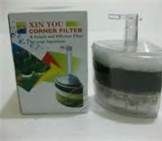
Another commonly used filter system used is the Hang On Back Filter (HOB)
Hang On Back (HOB) Filters are like internal filters except that they are hanged externally on the back.
The advantage of HOB filters is that they are space saving and does not take up space inside the tank. There is also good surface agitation and water circulation because of the water flowing in from the top on the water surface.
The disadvantage of HOB filters is that they usually have very limited space for housing bio media. Also, most of them require using specially made filter pads for mechanical filteration. In the long run, it can be costly as those filter pads are small and does not last long before they need replacing.
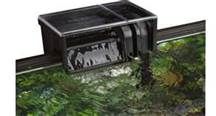
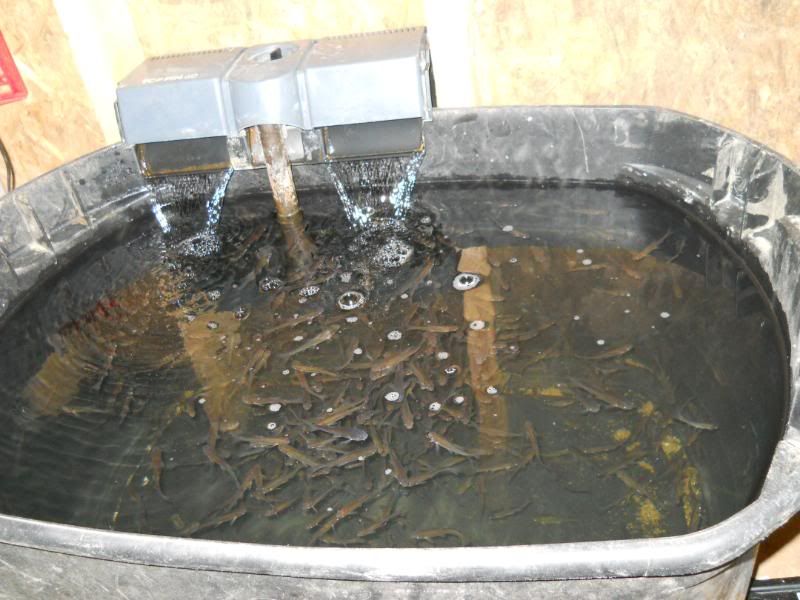
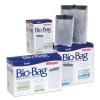
Next are canister filters. I know of quite a few members that are using these style filters for their bait tanks
Canister Filter
If you take an internal filter, increase its filter media compartment, make it watertight and connect it to your tank using two water tubes(water in+water out), you have a canister filter. While caninister filter is a relatively newer type of filter, like all filters it has it's advantages and disadvantages and is not necessary the best.
One advantage of the caninister filter is that it increases the total water volume of your aquarium system. This is a always a good thing, because a bigger water volume means a lower concentration of harmful byproducts of fish food and waste (such as dossolved organic compounds). Also, a bigger water volume means the water is more stable with less fluctuations in temperature and water parameters. Another advantage is that since it is situated out of the tank, your fish has more swimming space and also your tank looks 'cleaner' with less equipment in it. If the water outlet is connected to a rainbar, it will also aerate the water as well.
The disadvantage of caninisters is the hassle of doing regular maintainance. As a result, many users of caninisters do not maintain them as regularly as they should. This causes uneaten food and waste to collect on the mechnical filter (wool). Without washing or replacing, these debries decay and break down on the wool. the result is that the waste is just decaying in a different place. Instead of decaying in your tank, it decays in your filter. The impact on the system is a higher bioload because these wastes break down into extra ammonia, nitrites and nitrates when they should be removed from the system even before they break down. As you can see, caninister are better used for biological filtration. This makes it very suitable for a type of aquarium that produces little solid waste and uneaten food, the natural aquarium (aka planted aquarium/planted tank).
Note: There has also been cases of leaks causing a minor flood on the floor of the home of some aquarists so if you do get a canister filter, go for a good one so you don't have to worry about it when you go on vacations.

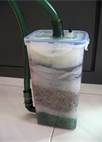

What I commonly refer to as a gravity filter is also known as a Over Head filter in most aquarist circles.
Overhead Filter (OHF)
Overhead filters works by situating the filter media above the tank water surface. Water is pumped up to above the filter media using a water pump or powerhead, which then flows pass the filter media and re-enters the tank by gravity.
There are 2 very big advantages of using overhead filters. Firstly, beneficial bacteria are able to work very effectively due to the excellent air/water interaction at the filter media. Secondly, it is very easy to do maintainance. The lid can be opened and the wool replaced in seconds without turning off the power supply. Uneaten food and solid fish waste can be easily and regularly removed before they can break down, reducing the bioload on the system.
There is enough gas exchange between the water and air at the water inlet and outlet zones such that aeration with air pump is not necessary and in fact redundent in most situations where the tank is not being seriously overstocked. Water reentering the tank from the top also effects good water circulation in bringing water with dissolved oxygen from the water surface down to lower regions.
The disadvantage of the overhead filter is that the pump take up space inside the tank although the media is above the tank. The water pump and tube channeling water upwards can also look unsightly and visually obtrusive. (There are some types of overhead filters that have the pump above the water surface where water is drawn up using a vertical pipe, but be sure to get one from a reputable brand if you get this type. There has been real and documented cases where they overheat and cause fires, even burning down the house of some victims.)
Another disadvantage is that should the connection between the water tube and the filter box be loosened and disconnected, the tube could actually start channeling water outside the filter box onto the floor. If your water pump is placed on a low position inside the tank, most of the water could be drained out and cause a minor floor on the floor besides the impact on your aquatic livestock.

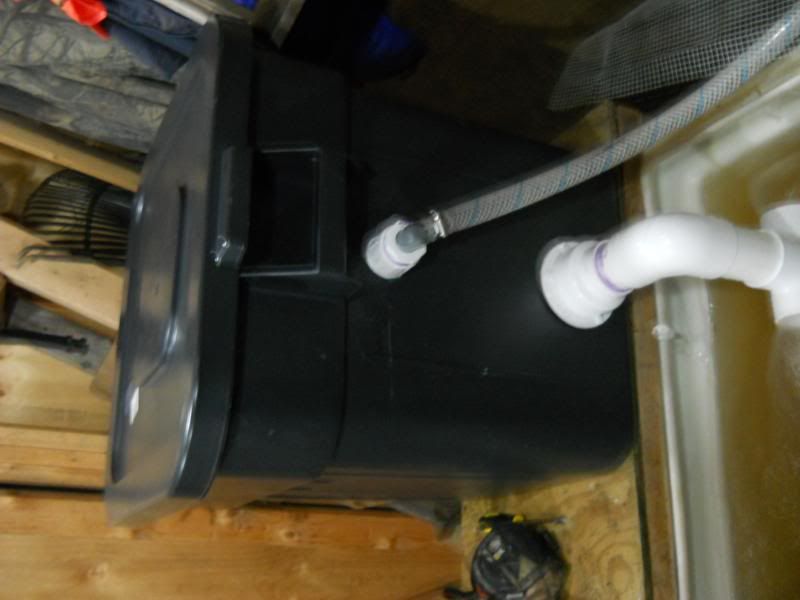
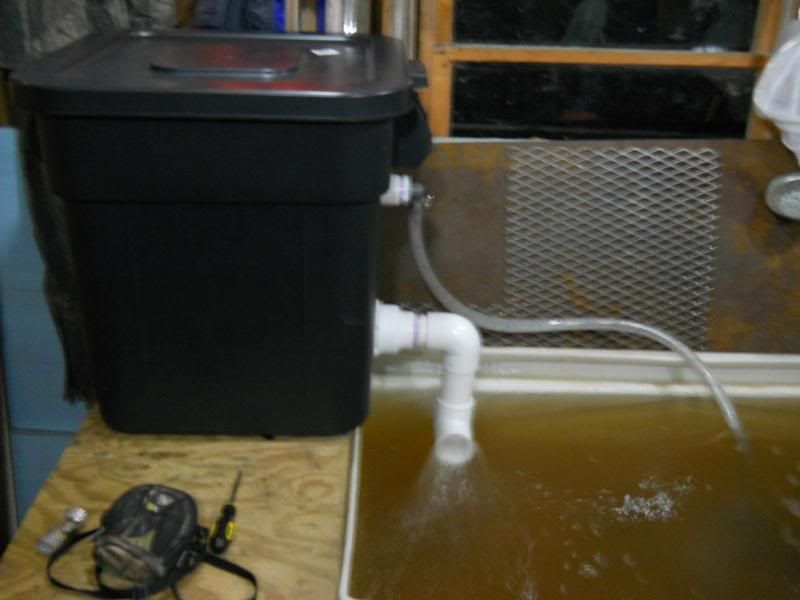

There are other types of filters out there such as stackable Over head filters, Sumps, Internal overflow sump. Pretty much any aquarium/pond style filter system can be adapted to be used with a bait tank because basically that's all your creating is a aquarium. Your stocking rates as far as fish per gallon of water in a bait tank are going to be extremely higher than what is recommended for an aquarium of the same size. Thats where your filter will come into play to ensure that it can handle the bioload.
Three types of Filtration
Mechanical, biological, and chemical
Mechanical Filtration
Mechanical filtration is incorporated into most filters so that solids such as uneaten food, dead plants, solid fish waste and suspended particles can be effectively removed from the tank. Without mechanical filtration, biological filtration would need the solids to rot and break down, resulting in extra load on the biological filter. Mechanical filtration usually acts as the first stage of filtration in a filter. This is why sometimes it is also called a pre-filter.
Mechnical filter is essential because it:
Enables solid waste to be removed so that the water has less suspended particles and look more clear
Reduces the workload on the beneficial bacterias through exported waste from the system.
Prevents clogging up of biological media. (Bio media are very porous so that they have a larger surface area. If these pores get clogged up, then the surface area is decreased and less beneficial bacteria can be housed. )
Mechanical filter media includes
filter wool
filter sponge
scrubber
filter paper
They all come in different shapes and sizes. If you want to save cost, you can buy them in bulk from your supplier because they don't have an expiry date and it is just a matter of time before you need them. In fact, it might even save you some transport costs of buying them in several trips each time they run out. If you have access to a bigger store with a wider variety and range of products, you may even be able to find them in large sheets. You can then cut them to size to suit your filter.
Caution: Some sponges used in mattresses or pillows or toys have anti-mold, anti-fungus or anti-bacteria chemicals on them that are harmful to your biological filtration and your fish! So be careful if you are going to be scrounging up your own filter material. Depending on the quality of the material, you may be able to wash and reuse mechanical filters a few times before they deteriate too much and need to be replaced. Filter sponges and scrubbers can be washed and reused many times but filter wool tend to break down fast and have to be replaced. If you use filter paper in your system, replace and throw away the old piece when it is full. Don't wash them because it is impossible to get all the super fine particles out. You would only loosen some of them and let it go back to your water if you do!
Arrangement
Mechanical filters should always be arranged so that the water passing through meets the coarser filters first before the finer filters so that the filtration is more efficient. (eg. filter paper should always be at the last stage of mechanical filtration before the water goes to bio filter) Mechanical filtration is the physical removal of waste from the water using something to trap the solid particles. Mechanical filtration cannot remove dissolved waste chemicals. Mechanical filtration needs to be regularly washed or replaced. Otherwise, the trapped particles can either clog up the water flow or break down and bypass the filter.if you put the course filter above the finer filter, the waste load is distributed evenly. As a result, you would need to change the filter less frequently because different filters are filtering different sized particles.If you arrange it such that the finest filter is above, all the waste is trapped by the first layer. As a result, it becomes "saturated" fast and you will need very frequent maintenance. If the filter with larger pores are below the fine filter, whatever particles that could squeeze through the fine filter will not be trapped by the coarser filters below it.
Biological filtration
Biological filtration is the removal of waste chemicals by the action of beneficial bacteria living in the bio media. When the water is passed through the media, the beneficial bacteria consumes ammonia and converts it to nitrites and then to nitrates. Bio filtration is the best filtration and it does not need replacing. In fact, the older your bio filter, the more established it is.Biological filtration is the removal of harmful waste chemicals that is produced by fish waste and uneaten food in the aquarium. These waste products causes the rise of ammonia in the water. Ammonia is very toxic in high levels and it is a common cause of fish deaths in new tanks for people who fail to keep ammonia levels in check.
For biological Filtration to be set up we need
A compartment that water flows through
Bio media for bacteria to establish and grow on
Beneficial bacteria
The main thing in bio filter is the beneficial bacteria. Without the beneficial bacteria, there is nothing to carry out the bio filtration.
The process where the beneficial bacteria consume chemical waste and converts them into less harmful chemicals while multiplying in numbers to establish themselves is called cycling. When the bacteria has grown to numbers sufficient to convert all excess chemical waste so that ammonia levels and nitrite levels is zero, we say the tank has cycled.
Flow rate and Beneficial Bacteria
The main consideration of flow rate for beneficial bacteria is that your pump should be able to deliver the water to them fast enough. The higher the flow rate is, the better it will be. A a general guideline, the flow rate should be big enough to cycle the water through the biological media 4-5 times per hour.
There is some rumors that a high flow rate can impact on the ability of the bacteria to process the nitrogenous waste. However, it is not a concern because assuming that beneficial bacteria cannot do well in a high flow area, they can still live on the inside surfaces of porous media which makes up the bulk of the total surface area available to them. (Flow rate is only a concern in a denitrator that uses a coiled air tube where the only area that the beneficial bacteria is growing on is on the inside surface of the coiled air tube where it is directly affected by the flow rate.)
What is more important than flow rate is the way the water flow. In a proper biological filtration setup, water is channeled to flow through the media evenly. One common mistake fish keepers make is to deploy the bio media in such a way that water flows around it instead of through it.
We must not forget that water flows using the easiest path it finds. Using holding bags to contain media often create gaps in between bags, allowing water to flow past the sides of the bags and little through the media. If media bags is to be used, the most efficient way to deploy them would be to have the bags closely touching all the sides of the filter chamber.
iological Media (Bio media)
Other than the beneficial bacteria, the most important thing would be the biological media. Bio media is the 'land' that beneficial bacteria lives in, grow and multiply.
Anything that does not rust nor leak harmful substances into the water can be used as bio media because beneficial bacteria is not choosy. They can grow on anything that they can attach themselves to. In fact, these bacterias are on your aquarium walls, gravel, decorations, plants and even on your fish!
Due to space constraint in the filter compartment, a good bio media provides a large surface while occupying a small space. Therefore, good bio media is made of porous materials because they give a very large surface area.
If there is no space constraint, then as long as they provide enough surface area for enough beneficial bacteria to grow on, such that they keep your nitrogenous waste under control, they are good bio media!
Common bio media are:
plastic bio balls
ceremic rings
lava rocks
You may be thinking, wait a minute, plastic bio balls are not porus! True, they are not porous and they do not have as much surface area as porous materials. However, if you have a large bio media compartment and do not have a tight space constraint, it is good to use bio balls because their advantage is that they are able to provide a lot of air (oxygen) for the beneficial bacteria if they are not submerged in water.
Another advantage of plastic bio balls is that they don't get clogged up because their surface areas are made up of relatively large gaps and not fine pores like ceramic material. When a ceramic material gets clogged, all that vast surface areas is gone!
Due to this reason, you should always have a good mechanical pre filter in place to provide mechanical filtration before the tank water reaches the bio filter.
Important Note on Prefiltering!
If you do not use a prefilter (mechanical filter) you can still get good results AT FIRST. This is because if you have porous bio media, they can trap dirt and debris and work like a mechanical filter. The only problem is while you can wash or throw away your prefilter(i.e. wool) easily, you cannot do the same to your bio media otherwise you will destroy the beneficial bacteria colonizing on them.
Comparing Biological Medias
If you compare different bio medias OVER A PERIOD OF TIME all of them will give you the same result. The differences are
Beneficial bacteria can work better in some media because the surfaces on the media are more exposed to oxygen rich water.
Different amounts of media is required for different media because of different surface area they contain. (A more porous media with smaller holes/pores have more surfaces , but most surfaces have less access to oxygen rich water that is required for beneficial bacteria to work efficiently).
The only difference is that different media require different maintenance because some clog up easier than others.
Deployment of media is important. A media that is above the water level so that the water flows over it is more efficient. This is the more oxygen rich environment for the media.
If you compare a porous and non porous media side by side, the porous media will always show better results in the short term. This is because the micro holes and tunnels in the porous media traps tiny particles in the water. This in effect polishes the water so it looks more clear. This effect will slowly taper off as the pores of the media gets clogged up.
Chemical Filtration
Chemical filtration is the use of chemical process to filter the water. It can be in the form of solutions that bind particles together so that they can be picked up by the mechanical filter, or in solid form such as activated carbon and zeolite. Chemical filtration have a 'limit' of how much they can filter. When they are "full", they need to be replaced.
Some common chemical filtration is
Activated Carbon - removes dissolved organic substances
Zeolite - removes ammonia
Chemical filtration should only be used in emergencies and not as a permanent filtration that you keep replacing regularly.
Chemical filteration and their uses:
Activated Carbon
Activated carbon can be thought of like a vacume cleaner, taking in everything that it comes across. It is useful for removing medications from the water after you cure your fish and you do not want the medication to linger in the water. (Medications is generally harmful to aquarium plants and the biological filter, do not use medications unless absolutely necessary! You should cure your fish in a separate hospital tank whenever possible. In extreme cases where you have to medicate your main tank, always remove medicine traces after your fish are cured! Learn about curing fish diseases here)
Other than removing medications, it is also useful in removing color caused by driftwoods or dried leaves etc.
Activated carbon also removes ordous. However, note that a healthy aquarium should not have ordors! Don't treat the symptom without treating the source!
Zeolite and other ammonia removal chemicals
Zeolite is used to remove ammonia from water. There are also other chemicals that removes ammonia from aquariums, however for this section we use zeolite to represent zeolite as well as those other ammonia removal chemicals so this will be more readable..
As said earlier, zeolite should not be used as a permanent solution to your aquarium filtration even if you replace the zeolite regularly when they get 'full'. They should only be used in temporary installations where you don't biological filtration in place, for example temporary feeder fish tanks, quarrantine tanks, hospital tanks etc. You don't want to have bio filtration is these tanks because you often need to medicate these tanks. When you medicate, you'll destroy the bacteria colonies and wreck your bio filter anyway. And being temporary tanks, the bacteria colonies does not have any supply of waste chemicals to sustain the bacteria colonies when their fish are moved into your main tanks.
When you use zeolite, you are artificially removing ammonia (which reduces nitrites as well since nitrites is converted from ammonia). As a result, you 'trick' the biological filter into thinking that you have a smaller bioload than you actually have. As a result, your beneficial bacteria colonies downsizes as the 'excess' bacteria staves and dies.
While this is fine while your zeolite is hungrily absorbing ammonia, what happens when they are full and will not absorb anymore? When this happens, your beneficial bacteria will have to slowly multiply to increase their capacity to process the suddenly increased ammonia and nitrites. Before they have multiplied sufficiently, your aquarium will have these excess waste chemicals in the water. How much a spike it will cause depends on how much zeolite you were using.
Instead of replacing zeolite and wasting your money and time, why not let your beneficial bacteria handle it for FREE!!!